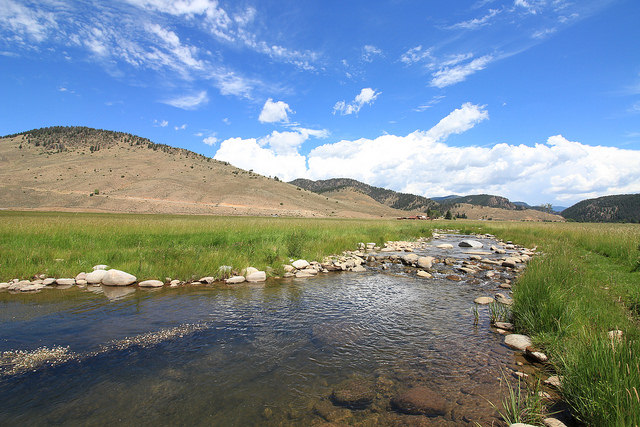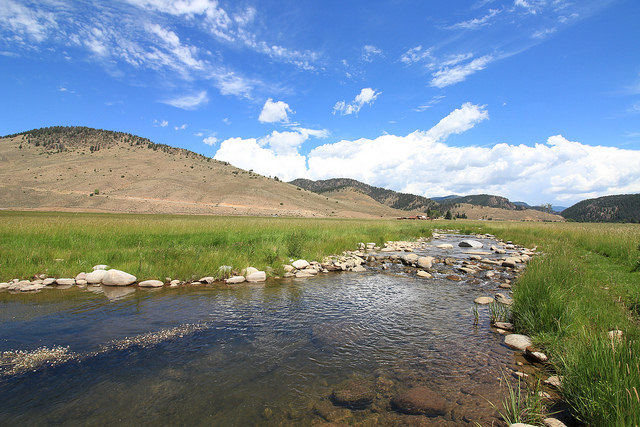As we roll into August, here is the Wilder on the Taylor Fly Fishing Report.
Low flows and high water temperatures are the rule for the entire state of Colorado. With a poor winter snowpack, little rain and hot temperatures many local rivers are too warm to fish during the afternoons and voluntary closures have been in effect for a few weeks. Fortunately, at Wilder we are lucky to have good flows from Taylor Park Reservoir and low water temps due to the fact that the Taylor River water is released from the bottom of the dam. Flows almost are in the 270 cfs range and the dam is currently releasing 225 cfs. This will continue until August 16, when flows will be reduced to 200 cfs through the month of August. Current water temperatures range from 49- 57 degrees which is ideal for trout, bugs and fishermen.
Late Summer Fishing
As happens every year, fishing has tightened up a bit in the last couple of weeks after an epic July. Fish are less aggressive and insect hatches are more sporadic and less intense, requiring anglers to concentrate on stealthy presentations and small flies. In July many large bugs are hatching in large numbers and fish are fairly willing to eat. Now the bugs are getting smaller and scarcer, necessitating tippets of 6x and leaders longer than 9 feet to ensure success.
On the Taylor River some good dry fly action can be found in the mornings as Mayfly Spinners that have hatched during the last day or two, return to the water to lay their eggs and complete their life cycle. You will see these long tailed, delicate spinners dipping and diving over the water in the a.m.’s, generally before 10 o’clock, when air temps hit 60 degrees. Once the eggs are laid, the spent adults fall to the water with their wings outstretched like an airplane. These are spent spinners and in the right water, fish will be feasting on them and you will see them rising softly. This only happens in slick water and smooth tail outs so don’t waste your time looking in fast currents. A size 16 Rusty Spinner pattern can be very effective during these Spinner Falls. Remember, that Spinners are dead meat. They do not move around and the fish know it. Make sure your presentation reflects this, as a moving spinner will not work. I have seen most of the spinner activity between 7-9:30 am. Once the sun gets high, it is over. Around 9:30-10 a.m. surface activity slows down considerably. Fish return to their lies on the bottom of the river where they are likely to remain until a hatch occurs.
Hatches
This time of year, hatches can occur almost anytime from 11 a.m. through 4 p.m. Cloudy days produce the best hatches and these can include BWO, PMD, and Flavilinea Mayflies, Craneflies and an assortment of different size and color Caddis. Most prolific are the BWO’S and these will remain the most important Mayfly through the end of our season. It is always a good idea to carry several different BWO dries and nymphs as fish can be very selective during strong hatches. I like to fish a BWO dry with a dark wing. Even though hard to see, light winged patterns seem to get more refusals as the naturals have a darker dun-colored wing. These are small bugs and fly choices should be in the size 18-22 range.
Many days, there won’t be much of a hatch at all and fish are pretty inactive. In these circumstances, I like to use a size 12-16 Para Adams and a long 6x dropper (4 feet). For nymphs, I like Tung Head Micro May, Pheasant Tail, and Midges in sizes 16-22. Quiet presentations and good drifts are key. During the day you will see some Caddis activity although it is winding down for the season. Look for light colored egg layers bouncing off the water and very dark micro caddis hatching. Some fish will be concentrated on the Caddis but generally, these are the smaller fish and the larger ones prefer Mayflies. Dry/dropper combinations are best right now outside of a major hatch and a carefully fished dry dropper setup can be deadly. Midday if no hatches are happening, don’t hesitate to try terrestrial patterns such as Beetles, Ants and Grasshoppers. Sometimes a well placed terrestrial will bring up large trout. I like Para Hoppers, Chernobyl Ants and #16 – 20 beetle imitations. A dropper underneath a terrestrial can be a good technique. If the fishing is slow, don’t hesitate to experiment and try some different things. Sometimes, surprisingly, fish will respond to a large Stonefly dropper drifted deep in the holes even though Stonefly season is well behind us.
Regardless of what flies you are fishing and what is going on on the water, soft presentations and stealth will increase your odds of success. Move slowly, look around well and concentrate on having your fly or flies hit the water as softly as possible.
As we go through August, flows will be reduced even more, fish will get spookier and less active and hatches sparser. Once September hits we should see the fish and bugs getting more active and strong hatches of BWO’s and Gray Drakes will provide excellent surface action through October as the fish fatten up for winter.
The Dream Stream
The Dream Stream is in great shape considering the high air temps and low flows that the summer has brought. Water temps are starting to cool and remain in the low 60’s while fish continue to be quite active. Fishing is great!!! During the next couple of weeks, we will be cutting the hay and this brings on a feeding frenzy for grasshoppers. This can be the best time of year out there as big fish lose all caution and literally go crazy eating hoppers. I like sizes 8-12 Para Hoppers and Yellow-bodied Madame X’s fished on 3-4x tippets but any Hopper pattern that you have may work.
Due to the low flows and high temps of the summer, algae growth is pretty thick in the stream. Feeding lanes are getting narrower and it is a challenge to keep fish from burying themselves in the weeds and breaking your line. Stout tippets and fighting the fish as hard and fast as possible can help prevent this from happening.

For the Fish’s Health
For the next couple of weeks or so, we are recommending not fishing the Stream after 2 pm when the water warms up. Warm water carries less oxygen than cold water and fish do not recover well when water temps hit the mid 60’s. This restriction is voluntary and only applies to hot, sunny afternoons.
Regardless of what time of day, we ask that you do not remove the fish from the water, period, and take your time to make sure that the fish are fully revived before walking away to the next pool. Please double check to make sure that you have removed the barbs from your hooks.
Fishing the Ponds
All 6 of the ponds at Wilder have healthy trout populations and are fishing well. As in the Stream we are recommending not fishing the ponds much after lunchtime until the water temps drop towards the end of the month. Current water temps are in the low to mid 60’s. Fish are actively feeding on Midges in the mornings and Damselflies and Hoppers the rest of the day. Large terrestrial patterns are recommended and twitching a Hopper can produce devastating strikes. Walk the banks and look for cruising fish to cast to. As in the Stream, please do not remove any fish from the water and revive your fish carefully until they swim away strongly. Use heavier tippets to play and release fish quickly.
Considering that we are experiencing one of the driest, warmest summers on record in South-central Colorado, fishing and flows at the Wilder remain very good. Conditions on the Taylor River are excellent for wading and will continue to be for the remainder of the 2018 season.









